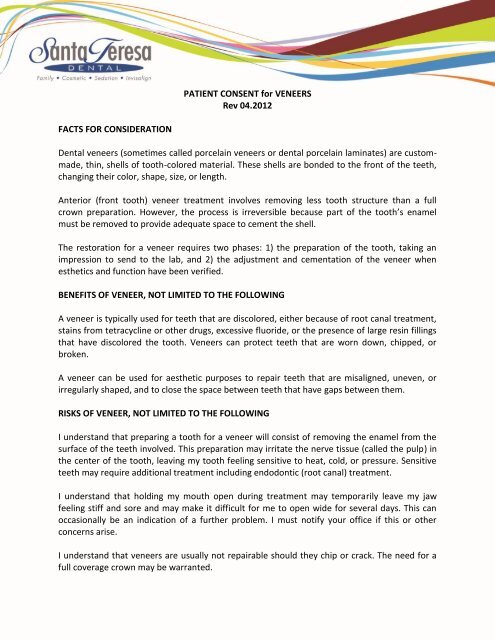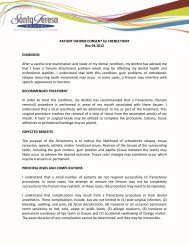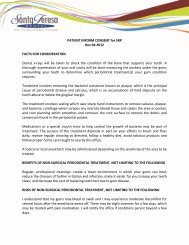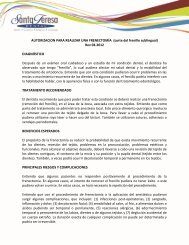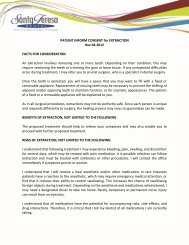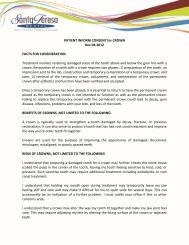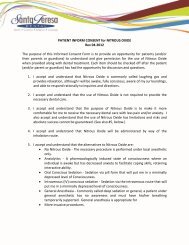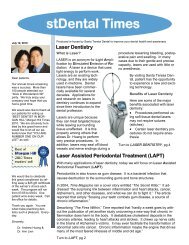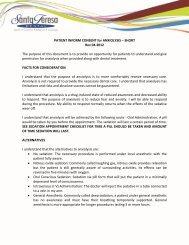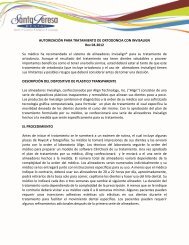Veneers - Consent Form
Veneers - Consent Form
Veneers - Consent Form
Create successful ePaper yourself
Turn your PDF publications into a flip-book with our unique Google optimized e-Paper software.
PATIENT CONSENT for VENEERS<br />
Rev 04.2012<br />
FACTS FOR CONSIDERATION<br />
Dental veneers (sometimes called porcelain veneers or dental porcelain laminates) are custommade,<br />
thin, shells of tooth-colored material. These shells are bonded to the front of the teeth,<br />
changing their color, shape, size, or length.<br />
Anterior (front tooth) veneer treatment involves removing less tooth structure than a full<br />
crown preparation. However, the process is irreversible because part of the tooth’s enamel<br />
must be removed to provide adequate space to cement the shell.<br />
The restoration for a veneer requires two phases: 1) the preparation of the tooth, taking an<br />
impression to send to the lab, and 2) the adjustment and cementation of the veneer when<br />
esthetics and function have been verified.<br />
BENEFITS OF VENEER, NOT LIMITED TO THE FOLLOWING<br />
A veneer is typically used for teeth that are discolored, either because of root canal treatment,<br />
stains from tetracycline or other drugs, excessive fluoride, or the presence of large resin fillings<br />
that have discolored the tooth. <strong>Veneers</strong> can protect teeth that are worn down, chipped, or<br />
broken.<br />
A veneer can be used for aesthetic purposes to repair teeth that are misaligned, uneven, or<br />
irregularly shaped, and to close the space between teeth that have gaps between them.<br />
RISKS OF VENEER, NOT LIMITED TO THE FOLLOWING<br />
I understand that preparing a tooth for a veneer will consist of removing the enamel from the<br />
surface of the teeth involved. This preparation may irritate the nerve tissue (called the pulp) in<br />
the center of the tooth, leaving my tooth feeling sensitive to heat, cold, or pressure. Sensitive<br />
teeth may require additional treatment including endodontic (root canal) treatment.<br />
I understand that holding my mouth open during treatment may temporarily leave my jaw<br />
feeling stiff and sore and may make it difficult for me to open wide for several days. This can<br />
occasionally be an indication of a further problem. I must notify your office if this or other<br />
concerns arise.<br />
I understand that veneers are usually not repairable should they chip or crack. The need for a<br />
full coverage crown may be warranted.
I understand that veneers may not exactly match the color of my other teeth. Also, the veneer's<br />
color cannot be altered once in place.<br />
I understand that while it is not likely, veneers can dislodge and fall off. To minimize the chance<br />
of this occurring, I should not bite my nails, chew on pencils, ice, or other hard objects, or<br />
otherwise put pressure on my teeth. Also, grinding or clenching my teeth may cause the veneer<br />
to become dislodged.<br />
I understand that the veneer will fit up near the gum line, which is in an area prone to gum<br />
irritation, infection, and/or decay. Proper brushing and flossing, a healthy diet, and regular<br />
professional cleanings are some preventative measures that are essential to helping control<br />
these problems.<br />
I understand there is a risk of aspirating (inhaling) or swallowing the veneer during treatment.<br />
I understand that I may receive a local anesthetic and/or other medication. In rare instances,<br />
patients may have a reaction to the anesthetic, which could require emergency medical<br />
attention, or find that it reduces their ability to control swallowing. This increases the normal<br />
chance of swallowing foreign objects during treatment. Depending on the anesthesia and<br />
medications administered, I may need a designated driver to take me home. Rarely, temporary<br />
or permanent nerve injury can result from an injection.<br />
I understand that ALL medications have the potential for accompanying risks, side effects, and<br />
drug interactions. Therefore, it is critical that I tell my dentist of all medications I am currently<br />
taking.<br />
I understand that every reasonable effort will be made to ensure the success of my treatment.<br />
CONSEQUENCES IF NO TREATMENT IS ADMINSTERED, ARE NOT LIMITED TO THE FOLLOWING<br />
I understand that if no treatment is performed, I may continue to experience symptoms which<br />
may increase in severity, and the cosmetic appearance of my teeth may continue to<br />
deteriorate.<br />
ALTERNATIVES TO VENEERS, ARE NOT LIMITED TO THE FOLLOWING<br />
I understand that depending on the reason I am choosing to have a veneer placed, alternatives<br />
may exist, including orthodontics for tooth alignment. I have asked my dentist about them and<br />
their respective expenses. My questions have been answered to my satisfaction regarding the<br />
procedures and their risks, benefits, and costs.
No guarantee or assurance has been given to me by anyone that the proposed treatment or<br />
surgery will cure or improve the condition(s) listed above.<br />
I have been given the opportunity to ask questions and give my consent for the proposed<br />
treatment as described above.


